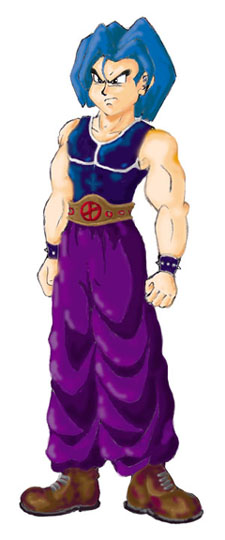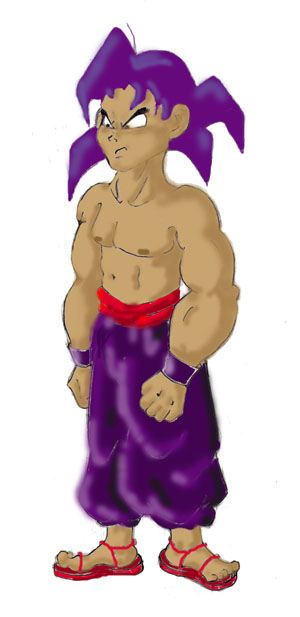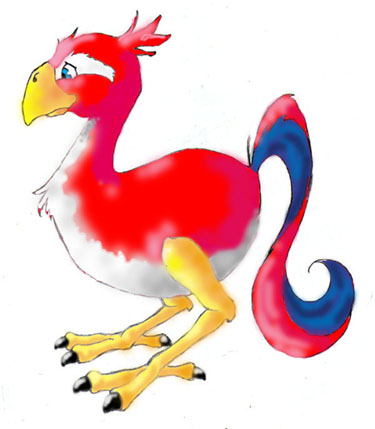
Senchar
The senchar are a very peacful people, they don't like having to go to war, but often times they are left no choice. Luckily as much as they dislike fighting, they are good at it and are able to hold their own on the field. They are tall, usually about six feet and weigh from 150 pounds and up. They are strong and hardworking, many live in the country on farms working in agriculture growing both plants and animals for food. These senchar produce most of the food for the rest of their people that live in the large cities of Rima. The senchar rely heavily on technology and are the most civilized race of all the beings on Rima. Their life of peace lets most reach into the elder years of sixty or seventy, but their life span varies greatly in general. They populate the northern continents of Rima, living in large cities, small villages, or out on the huge plains. The cities are filled to the capasity with people hurrying about their daily lives of buisness and trade, there are also many museums in the cities that hold the history of the senchar as well as their art. These museums are a good escape from the hurried life of the city. Churches are never placed in the cities themselves, but usually on the outskirts of them or in nearby villages. The senchar worship the gods Banero and Hento the gods of earth and sky. No sacrafices are made to them, instead the senchar opt for silent prayer to show their love to the gods. The government was a democracy untill the nichan came into power. The nichan is a group of senchar that forced out the old officials and reign over the people by means of force, killing any who don't obey. Since they took over the senchar have been in constant war for land although the common senchar does not believe land is important, they fight only so they and their families won't be killed my the nichan and their troops of followers.Senchar believe in marriage and are free to choose who and when they want to marry. Children are sent to schools at a young age so that they will be able to enter the work force by the age of 15. Along with Remish, they also speak segui which is used as a buisness language between them.

Waruis
Although small in size, usually reaching a hight of only four feet tall, the Waruis make up in strength what they lack in size. A warrior race by nature, the Waruis have evolved so that they can be efficiant fighters. There small size makes them hard to hit and they are very quick footed and agile making them a hard target. Their forearms are also larger in size and extremly strong so that they pack quite a punch. This increased muscle in their arms also allows them to pick up things four times their own weight (200 pounds on average). With a varying lifespan of anywhere from 25 to 40 years depending on how many battles they partake in, the Waruis dedicate their whole lives to improving themselves. Starting from about age five they begin their military training and by age 15 are allready fighting for their lives and nation. Each village is its own small army, with all the village leaders being militatry officials that command the people on what their new battle orders are. The wauris have a core of elite official that run all of the other villages and direct all actions taken by the village officials. These elite officers are brought to office by bloodrite and their offspring will take command after they have died. The only thing more important to the Waruis then their elite officials is their god, Wari. Wari is feared and loved by all, he is thought to bring victory or defeat to any battle depending on how well he is treated. Oracles are sent to ask of his advise before any extreme military action takes place. Sacrifices are made before every battle so that Wari will bring luck and good fortune to the army. The waruis sacrifice anything from prisoners to bakabir. Bakabir are the waruis main source of food, so sacrificing the animals is concidered just as good as a prisoner of war. A waruis status in the village is determined by how many enemies he has killed. The most respected are the elder warriors who tell stories of their victories to the younger generations. Many times a great warrior will have songs written about them that are sung for inspiration in battle. The females are looked down upon if they decide to enter an army, they are concidered to be good only for child bearing purposes and rarely leave their villages. The waruis speak two languages, the first being the universal language spoken by all intelligent life on Rima called Rimish. The second is their own native tounge called Warish, this is an extremely hard language to learn and no other race has been able to translate it. Although they have the capability for great technology they tend not to use it when neccesary, relying more on the ancient ways of doing things.

Bakabir
This bird like creature not only looks like a chicken, but it also has about the same intelligence level as one. In other words, they are stupid...very, very stupid. This incredible lack of brains is thought to be why they have such a short life span in the wild, on the average lasting two to three years at the most. In captivity this life span is usually increased by a few years, but in the end even the most careful owner usually loses the bakabir to some strange accident. It's size and strength make the bakabir perfect for farm work, standing at about seven feet tall and weighing in at around 250 pounds, the bakabir is used to carry heavy loads as well as plowing fields and any other assorted hard labor. Its' dull intellect makes it easily trainable and it's swift speed allows for quick and efficient work. The bakabir has long muscular legs that let it run long distances in a short amount of time even when carrying heavy loads, because of this they are also used for transportation by some. This becomes especially handy in the country where there are no real roads and the bakabir's steady pace and good footing make for an easy and comfortable ride. The bakabir lays an average of six eggs a year all at one time, these eggs are then abandoned and left to hatch on their own. The hatchlings arrive one month later and after breaking out of their shells immediately start out in search of other bakabir. The first herd they come across will be the one they live with the rest of their lives. Normally about two of the original six babies make it all the way to the point of finding a herd, the others are either killed or brought into captivity. Bakabir live in large herds of up to fifty and roam the grasslands and forests of Rima freely. Feeding off of the grasses and seeds of the wild, the bakabir spend most of their days grazing. It is a common sight to see the animals in the wild and they are under no threat of extinction. Although they are prized for their beautiful tail feathers and tasty meat, the population never seems to be hurt from hunting. Very social animals, the bakabir herds are often seen intermingled and no real territorial issues ever seem to come up with them, although it is plain to see that larger males are dominant over the smaller ones. Bakabir communicate by making low guttural noises, this is also how they tell herds apart because each herd has it's own distinct dialect. From this they can tell who is a member of their herd and who isn't, so even when mixed together no bakabir leaves with the wrong group.